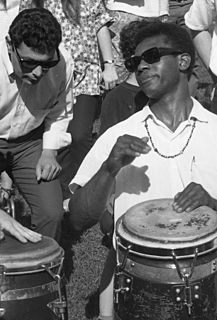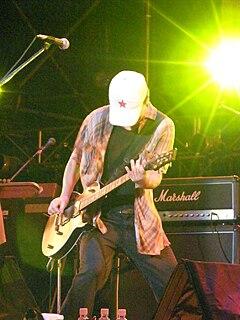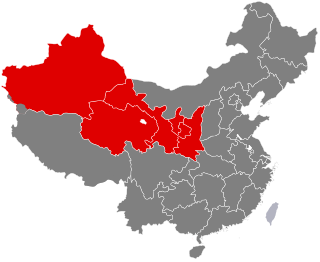Punk rock is a rock music genre that emerged in the mid-1970s in the United States, United Kingdom, and Australia. Rooted in 1960s garage rock and other forms of what is now known as "proto-punk" music, punk rock bands rejected perceived excesses of mainstream 1970s rock. They typically produced short, fast-paced songs with hard-edged melodies and singing styles, stripped-down instrumentation, and often political, anti-establishment lyrics. Punk embraces a DIY ethic; many bands self-produce recordings and distribute them through independent record labels and other informal channels.

Progressive music is music that attempts to expand existing stylistic boundaries associated with specific genres of music. The word comes from the basic concept of "progress", which refers to development and growth by accumulation, and is often deployed in the context of distinct genres such as progressive country, progressive folk, progressive jazz, and progressive rock. Music that is deemed "progressive" usually synthesizes influences from various cultural domains, such as European art music, Celtic folk, West Indian, or African. It is rooted in the idea of a cultural alternative and may also be associated with auteur-stars and concept albums, considered traditional structures of the music industry.
Pop music is a genre of popular music that originated in its modern form in the United States and United Kingdom during the mid-1950s. The terms "popular music" and "pop music" are often used interchangeably, although the former describes all music that is popular and includes many diverse styles. "Pop" and "rock" were roughly synonymous terms until the late 1960s, when they became increasingly differentiated from each other.
Rock and roll is a genre of popular music that originated and evolved in the United States during the late 1940s and early 1950s from musical styles such as gospel, jump blues, jazz, boogie woogie, and rhythm and blues, along with country music. While elements of what was to become rock and roll can be heard in blues records from the 1920s and in country records of the 1930s, the genre did not acquire its name until 1954.
Rock music is a broad genre of popular music that originated as "rock and roll" in the United States in the early 1950s, and developed into a range of different styles in the 1960s and later, particularly in the United Kingdom and in the United States. It has its roots in 1940s and 1950s rock and roll, a style which drew heavily on the genres of blues, rhythm and blues, and from country music. Rock music also drew strongly on a number of other genres such as electric blues and folk, and incorporated influences from jazz, classical and other musical styles. Musically, rock has centered on the electric guitar, usually as part of a rock group with electric bass, drums, and one or more singers. Usually, rock is song-based music usually with a 4/4 time signature using a verse–chorus form, but the genre has become extremely diverse. Like pop music, lyrics often stress romantic love but also address a wide variety of other themes that are frequently social or political.

A drummer is a percussionist who creates music using drums.
Arena rock is a style of rock music that originated in the mid-1970s. As hard rock bands and those playing a softer yet strident kind of pop rock became increasingly popular, groups began creating material inherently designed for large audiences, and arena rock developed from their use of more commercially oriented and radio-friendly sounds. The often highly-produced music, including both upbeat, dramatic songs and slower power ballads, features strong emphasis on melody and frequently employs anthemic choruses. Other major characteristics include prominent guitar effects and the use of keyboard instruments.
Alternative rock is a style of rock music that emerged from the independent music underground of the 1980s and became widely popular in the 1990s. In this instance, the word "alternative" refers to the genre's distinction from mainstream rock music. The term's original meaning was broader, referring to a generation of musicians unified by their collective debt to either the musical style or simply the independent, DIY ethos of punk rock, which in the late 1970s laid the groundwork for alternative music. At times, "alternative" has been used as a catch-all description for music from underground rock artists that receives mainstream recognition, or for any music, whether rock or not, that is seen to be descended from punk rock. Although the genre evolved in the late 1970s and 1980s, music anticipating the sound of the genre can be found as early as the 1960s, with bands such as The Velvet Underground.

Cantopop or HK-pop is a genre of popular music written in standard modern Chinese but sung in Cantonese. Cantopop is also used to refer to the cultural context of its production and consumption. The genre began in the 1970s and became associated with Hong Kong popular music from the middle of the decade. Cantopop then reached its height of popularity in the 1980s and 1990s before slowly declining in the 2000s and slight revival in the 2010s. The term "Cantopop" itself was coined in 1978 after "Cantorock", a term first used in 1974. Cantopop reached its highest glory with a fanbase and concert reaching Mainland China, Taiwan, Singapore, Malaysia, South Korea, Japan especially with the influx of songs from Hong Kong movies.

Music is an integral part of Mongolian culture. Among the unique contributions of Mongolia to the world's musical culture are the long songs, overtone singing and morin khuur, the horse-headed fiddle. The music of Mongolia is also rich with varieties related to the various ethnic groups of the country: Oirats, Hotogoid, Tuvans, Darhad, Buryats, Tsaatan, Dariganga, Uzemchins, Barga, Kazakhs and Khalha.
Progressive house is a style (subgenre) of house music. The progressive house style emerged in the early 1990s. It initially developed in the United Kingdom as a natural progression of American and European house music of the late 1980s.

Chinese rock is a wide variety of rock and roll music made by rock bands and solo artists from native Chinese-speaking regions. Typically, Chinese rock is a fusion of forms accompanying the grand presentation of traditional Chinese music.
A clique is a close social group.

Northwestern China includes the autonomous regions of Xinjiang and Ningxia and the provinces of Shaanxi, Gansu, and Qinghai.
The Bakersfield sound is a genre of country music developed in the mid- to late 1950s in and around Bakersfield, California. Bakersfield was the first genre of country music to be significantly influenced by rock and roll, and as a result, the first to rely heavily on electric instrumentation and a defined backbeat. It was also a reaction against the slickly produced, orchestra-laden Nashville sound, which was becoming popular in the late 1950s. The Bakersfield sound became one of the most popular and influential country genres of the 1960s, initiating a revival of honky-tonk music and influencing later country rock and outlaw country musicians.
Gangtai are the C-pop artists and musical style from Hong Kong or Taiwan.

Northwest Minzu University, formerly known as Northwest University for Nationalities, is the first minority institution of higher learning founded in China after the establishment of the People's Republic of China, directly under the State Ethnic Affairs Commission of PRC. The university is in Lanzhou, Gansu Province and covers a land area of 474 acres (1.92 km2). It has two campuses: Northwest Xincun and Yuzhong.

"Nothing to My Name" is a 1986 Mandarin-language rock song by Cui Jian. It is widely considered Cui's most famous and most important work, and one of the most influential songs in the history of the People's Republic of China, both as a seminal point in the development of Chinese rock music and as a political sensation. The song was an unofficial anthem for Chinese youth and activists during the Tiananmen Square protests of 1989.

Xishan District is one of five urban districts of Wuxi, Jiangsu Province, People's Republic of China.
Popular music is music with wide appeal that is typically distributed to large audiences through the music industry. These forms and styles can be enjoyed and performed by people with little or no musical training. It stands in contrast to both art music and traditional or "folk" music. Art music was historically disseminated through the performances of written music, although since the beginning of the recording industry, it is also disseminated through recordings. Traditional music forms such as early blues songs or hymns were passed along orally, or to smaller, local audiences.










